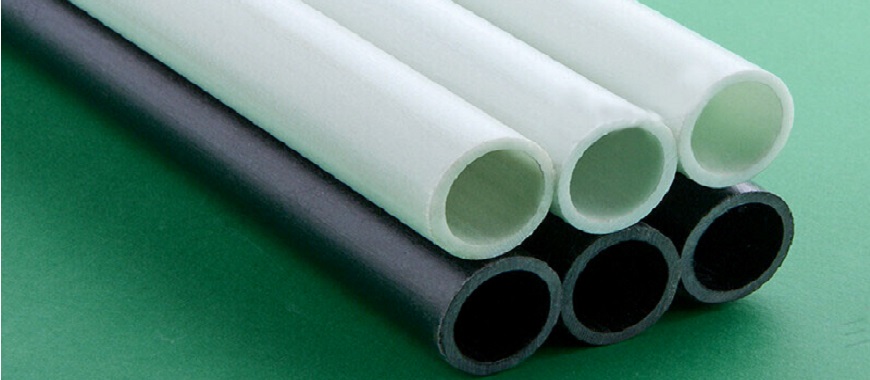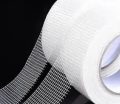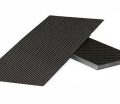
Fiberglass extruded tubes are versatile and durable products used in a variety of industries, from construction and aerospace to marine and automotive applications. These tubes are made by extruding fiberglass materials into tube shapes, providing a lightweight yet strong solution for many structural and functional needs. The primary advantages of fiberglass extruded tubes include their resistance to corrosion, high strength-to-weight ratio, and non-conductive properties, making them ideal for use in harsh environments. Similar to marine fiberglass pipes, when selecting a fiberglass extruded tube, it’s crucial to consider factors like size, wall thickness, and material properties to ensure the tube meets the specific demands of your project. Choosing the right fiberglass extruded tube is essential for optimizing performance, durability, and cost-effectiveness.
What Is a Fiberglass Extruded Tube?
A fiberglass extruded tube is a type of tube made from fiberglass that is created using the extrusion process. In this process, fiberglass strands are combined with a resin to form a thick paste, which is then pushed through a die to create the desired tube shape. The material is heated and formed into long tubes of varying diameters and wall thicknesses, and once cooled, the tube is cut to the required lengths. This method allows for high production efficiency and cost-effectiveness, making fiberglass extruded tubes widely used in a variety of industries.
Main Feature of Fiberglass Extruded Tube
The main feature of an extruded fiberglass tube is its strength combined with lightness, offering a strong yet lightweight alternative to materials like metal and plastic. These tubes are non-conductive, corrosion-resistant, and have excellent durability, making them ideal for environments where traditional materials might fail.
Fiberglass Tube Dever Supplies for Industrial Applications
Fiberglass extruded tubes differ from other types of fiberglass tubes, such as pultruded fiberglass tubes, primarily in the manufacturing process. While extruded tubes are created by forcing material through a die, pultruded tubes are produced using a process where continuous fiberglass strands are pulled through a resin bath and then shaped and cured. Pultruded fiberglass tubes tend to have higher strength and more uniformity compared to extruded tubes, making them suitable for applications where greater structural integrity is needed. For projects requiring enhanced durability and stiffness, the rigid fiberglass tube offers an excellent solution, providing a strong yet lightweight option for various structural and industrial uses. However, fiberglass extruded tubes remain a popular and cost-effective choice for a wide range of applications, thanks to their balance of strength and affordability.
Key Benefits of Fiberglass Extruded Tubes
Strength and Durability
Fiberglass extruded tubes are known for their high tensile strength, which makes them resistant to bending and impact. This strength allows them to maintain structural integrity under extreme conditions such as high temperatures or heavy loads. Whether used in construction, aerospace, or automotive industries, fiberglass extruded tubes can withstand challenging environments, providing long-lasting durability.
Corrosion Resistance
One of the standout features of fiberglass extruded tubes is their resistance to corrosion. Unlike metals such as steel or aluminum, fiberglass does not rust or degrade when exposed to moisture, chemicals, or salty air. This makes fiberglass extruded tubes ideal for use in harsh environments, including marine settings, industrial applications, and other corrosive conditions.
Lightweight and Cost-Effective
Compared to metals like steel and aluminum, fiberglass extruded tubes are significantly lighter, which reduces the overall weight of structures or equipment. This lightweight property is particularly valuable in industries such as aerospace and automotive, where weight reduction is crucial for performance and fuel efficiency. Additionally, fiberglass extruded tubes are cost-effective, providing an affordable alternative without compromising on strength or durability.
Electrical Insulation
Another key benefit of fiberglass extruded tubes is their excellent electrical insulation properties. They are non-conductive, which makes them ideal for electrical applications where the prevention of electrical conduction is essential. This property makes fiberglass extruded tubes a reliable choice for use in electrical housings, wiring conduits, and other applications where safety and insulation are critical.
How Carbon Fiber Extrusions Improve Structural Stability
Fiberglass Extruded Tube Sizes
When selecting a fiberglass extruded tube for a specific application, understanding the available sizes is crucial to ensuring the tube will meet the demands of the project. Fiberglass extruded tubes come in a wide range of sizes, which can be customized to suit specific needs. Key dimensions to consider include diameter, wall thickness, and length.
- Diameter:
Fiberglass extruded tubes are available in various diameters, from small tubes used in delicate applications to large diameter fiberglass tubes designed for heavy-duty tasks. Common diameters for fiberglass extruded tubes range from as small as 1″ fiberglass tube to larger options, up to 14 inches or more, depending on the requirements. Large diameter fiberglass tubes, for example, are often used in industries such as water treatment or chemical processing where higher strength and durability are necessary. Tubes with diameters such as a 3-inch fiberglass tube are commonly used in applications that require a balance of strength and lightness. - Wall Thickness:
Wall thickness is another important factor to consider when choosing a fiberglass extruded tube. The thickness of the wall affects the tube’s overall strength, durability, and resistance to impact or pressure. Wall thicknesses for fiberglass extruded tubes can vary widely, from as thin as 0.080 inches (2.03 mm) to over 1 inch (25.4 mm). Thin fiberglass tubes, with their lightweight construction and reduced wall thickness, are often preferred in applications where flexibility and ease of handling are essential. The right wall thickness depends on the application, as thinner walls may be more suitable for lightweight applications, while thicker walls provide greater strength for industrial or heavy-duty use.
Essential Guide for Fiberglass Tube Near Me Suppliers
- Length:
The length of fiberglass extruded tubes is typically available in standard cut lengths or can be customized for specific projects. Some common lengths include 60 inches, 72 inches, and custom lengths to meet project requirements. Tubes can be cut to size based on customer specifications, whether for a single project or large-scale production needs. - Custom Sizing Options:
Many suppliers of fiberglass extruded tubes offer custom sizing options, allowing customers to specify the exact diameter, wall thickness, and length they require. Customization is particularly useful for specialized applications in industries like aerospace, automotive, and construction, where specific dimensions are necessary to ensure a proper fit. Additionally, some manufacturers may also offer options for telescoping tubes, which are adjustable in length, adding versatility for various applications.
When choosing the right dimensions for a fiberglass extruded tube, it’s important to consider factors such as load-bearing requirements, environmental conditions, and space constraints. By understanding the available sizes and customization options, you can select the best fiberglass extruded tube to ensure optimal performance for your specific needs.
Where to Find Fiberglass Extruded Tubes
Major Retailers
Many well-known home improvement and industrial supply retailers carry fiberglass extruded tubes in various sizes and specifications. These retailers provide a variety of options in terms of diameter, wall thickness, and length, making it convenient for customers to select the best fiberglass extruded tube for their project.
GangLong Fiberglass Online Sale
If you’re looking for specialized or custom-sized fiberglass extruded tubes, GangLong Fiberglass is an excellent option. We offer a comprehensive online catalog of fiberglass extruded tubes, along with customization services for specific project requirements. Whether you need standard sizes or bespoke dimensions, GangLong Fiberglass provides detailed product descriptions and competitive prices, making us a reliable source for purchasing fiberglass extruded tubes directly from the manufacturer.
Direct Manufacturers
For bulk orders or highly specific requirements, buying directly from fiberglass extruded tube manufacturers is often the best choice. Many manufacturers offer customization options, and purchasing directly from them can result in lower prices and a wider selection.
Applications of Fiberglass Extruded Tubes
Industrial and Commercial Uses
Fiberglass extruded tubes are often used in industrial and commercial applications due to their durability and strength. They are commonly employed in railing systems, where their corrosion resistance makes them ideal for both indoor and outdoor use. These tubes also serve as structural supports and framing elements in construction projects. In environments where both non-metallic and metallic components are utilized, GRP metal can be integrated alongside fiberglass extruded tubes to enhance structural stability and longevity. Their lightweight yet strong properties make them perfect for use in applications where both strength and ease of handling are necessary. Fiberglass extruded tubes are used in support structures for machinery, equipment, and safety barriers in industrial environments.
Aerospace and Automotive
In aerospace and automotive industries, fiberglass extruded tubes are used extensively due to their lightweight nature. In these sectors, reducing weight is essential to enhance fuel efficiency and performance. Fiberglass extruded tubes are used in various mechanical and structural applications, including reinforcement for vehicle parts, lightweight framework for aerospace structures, and parts for high-performance vehicles. Their non-conductive and non-magnetic properties are also advantageous in applications requiring electrical insulation or electromagnetic shielding.
Marine and Marine Safety
The marine industry is another sector where fiberglass extruded tubes play a crucial role. Due to their exceptional resistance to corrosion, these tubes are commonly used for boat framing, providing strength without the added weight of metal. They are also used in the construction of antenna housings for boats and other marine vehicles, as well as in various marine safety applications such as lifelines, flagpoles, and railings. Fiberglass extruded tubes are perfect for marine environments because they can withstand prolonged exposure to water and salt, preventing rust and deterioration that can affect metal parts.
Construction
In the construction industry, fiberglass extruded tubes are used for a variety of structural and non-structural purposes. They are commonly used as structural supports in framing, offering a lightweight alternative to traditional metal supports while maintaining high strength and stability. Additionally, fiberglass extruded tubes are employed as insulators in electrical systems, where their non-conductive properties make them ideal for use in wiring and conduit applications. Custom framing using fiberglass extruded tubes is also popular for creating lightweight and durable structures in both residential and commercial buildings.
FAQS about Fiberglass Extruded Tube
Yes, fiberglass can be extruded. Extrusion is a manufacturing process where raw materials are forced through a mold to form continuous shapes, such as tubes, rods, or profiles. Fiberglass extrusion involves combining fiberglass strands with resin to create durable, lightweight, and strong extruded products. This process allows for the production of consistent shapes and sizes, which are ideal for a wide range of applications, including structural components, electrical insulators, and protective casings.
Fiberglass extruded tubes are popular due to their high strength-to-weight ratio, resistance to corrosion, and excellent electrical insulation properties. The extrusion process also enables the creation of custom profiles to suit specific requirements, such as varying tube diameters, wall thicknesses, and lengths. Fiberglass extrusion is often preferred for applications that require a cost-effective alternative to metals like aluminum or steel, especially in environments exposed to moisture or chemicals.
Fiberglass tubes are versatile and find use in many industries due to their strength, durability, and resistance to corrosion. These tubes are commonly used in structural and framing applications, such as support beams and protective casings, where they provide an excellent balance of lightweight and durability. In the construction industry, fiberglass tubes are used for custom framing, structural supports, and insulating pipes.
In the aerospace and automotive sectors, fiberglass tubes are employed in lightweight components like frames and housings. These tubes help reduce the overall weight of vehicles while maintaining structural integrity. Additionally, fiberglass tubes are used in marine environments for boat framing and antenna housings, as they are highly resistant to water, salt, and other harsh conditions.
They are also ideal for electrical applications because they are non-conductive, making them suitable for insulating wires and cables. Whether for commercial, industrial, marine, or electrical uses, fiberglass tubes offer long-lasting, cost-effective solutions across a variety of applications.
Cutting fiberglass tubes requires careful handling and the right tools to ensure clean cuts and avoid damaging the tube. The process can be a bit more involved than cutting metal or plastic tubes due to the material’s density and rigidity.
To cut fiberglass tubes, start by using a saw with a fine-toothed blade. A hacksaw or a band saw equipped with a blade designed for cutting composites works well. You should always wear protective equipment, including gloves, goggles, and a dust mask, as cutting fiberglass can release harmful dust particles. It’s important to secure the tube properly in a vice or clamp to prevent it from shifting during the cutting process.
Once the tube is secure, measure and mark the cutting line carefully before starting the cut. Proceed slowly and steadily to avoid cracking or splintering the fiberglass. If a cleaner edge is needed, you can use a rotary tool or sandpaper to smooth the cut edges. After cutting, it’s essential to clean the tube and remove any fiberglass dust or debris before proceeding with further assembly or installation.
An FRP (Fiberglass Reinforced Plastic) square tube is a type of composite material tube made from fiberglass and resin. It combines the strength and durability of fiberglass with the versatile properties of plastic, resulting in a highly resistant material that is lightweight, corrosion-resistant, and durable under extreme conditions. FRP square tubes are formed through a molding process that creates a solid, square-shaped tube with high structural integrity.
These tubes are often used in applications where traditional materials like metal or wood would not be ideal. The square shape allows for easier stacking, storage, and installation compared to round tubes, making them a popular choice for structural framing, construction projects, and various industrial uses. FRP square tubes are commonly found in settings where resistance to corrosion and harsh chemicals is crucial, such as in the chemical, marine, and wastewater treatment industries.
The use of FRP square tubes is also widespread in areas requiring non-conductivity, such as electrical insulation applications. They can be used for cable management, support frameworks, and piping systems, offering a long-lasting and cost-effective solution for both outdoor and indoor environments.

As the editor of GangLong Fiberglass, I have years of experience and in-depth research, focusing on cable tray products, fiberglass solutions, and grille systems. I incorporate years of industry insights and practical experience into every content, committed to promoting the progress of the industry. At GangLong Fiberglass, my commitment is reflected in every product, from innovative cable trays to durable fiberglass solutions and sturdy grille systems. As an authoritative voice in the industry, my goal is to provide valuable information to professionals and businesses and promote forward-looking solutions.


